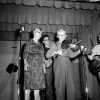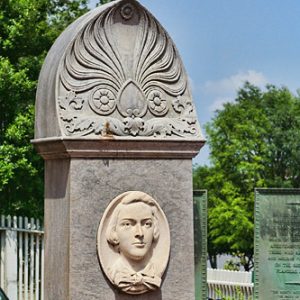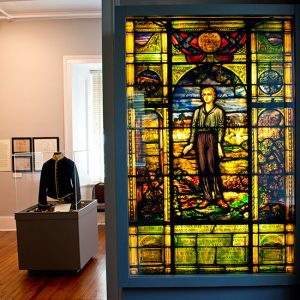calsfoundation@cals.org
Lost Cause Myth of the Confederacy
The Lost Cause myth consists of a set of ideas about the history of the South that developed following the American Civil War. These beliefs, which are largely considered by historians to be false, were advanced by contemporary Southerners as the so-called true story of the nature of the antebellum South, the reasons for Southern secession, and the character of the South’s people during the course of the war. The story comprised a defense of the South’s “peculiar institution” (slavery), secession, and the war. In Arkansas, the Lost Cause narrative developed with the emergence of various Confederate heritage organizations after the 1890s. These organizations worked to ensure that their interpretation was integrated into the accepted history of the state and reflected in public monuments, public holidays, and the educational curriculum. The ideas about the Civil War associated with the Lost Cause myth have remained a viewpoint accepted by many Arkansans into the twenty-first century.
The story of the Lost Cause began to be written almost immediately after the Civil War, outside of Arkansas. Edward Pollard, who had been an editor of the Richmond Examiner during the war, may have given the Southern interpretation its name with his 1867 book The Lost Cause: The Standard Southern History of the War of the Confederates, a history of the Civil War from a Southern perspective. Historian Gaines M. Foster points to other authors, however, who exerted greater influence on the particulars of the story. Albert T. Bledsoe’s defense of the former Confederate president, Is Davis a Traitor? (1866); Robert L. Dabney’s A Defense of Virginia (1867); and former Confederate vice president Alexander H. Stephens’s Constitutional View of the Late War (1870) shaped an interpretation of events that exonerated the South and Southerners from treason and defended their actions. Their interpretation was expanded and spread more widely in magazines such as Bledsoe’s Southern Review and The Land We Love (1866–1869), edited by former Confederate general Daniel H. Hill, who later became president of what is now the University of Arkansas (UA) in Fayetteville (Washington County). The Southern Historical Society, formed in New Orleans, Louisiana, in 1869 by former Confederate military leaders to counter what they considered to be partisan writings by Northerners, provided an additional forum for the Lost Cause perspective when it began publishing the Southern Historical Society Papers in 1876.
The Lost Cause narrative consisted of several basic tenets, all of which were embraced by its Arkansas advocates. The first element in this Southern version of history involved a set of ideas about the character of the antebellum South, which was pictured as a world populated by descendants of English cavaliers and happy slaves, a virtual paradise that produced brilliant statesmen and military leaders. The South’s labor system was depicted as a paternalistic one that existed for the good of African Americans, not for their exploitation.
The second set of ideas addressed by Lost Cause advocates involved the reasons for Southern secession and the subsequent war. In their view, slavery was not the source of the differences between the sections. Instead, they pointed to a clash of cultures and, more specifically, to Northern efforts at depriving Southerners of unspecified constitutional rights as the bases of Southern grievances. Secession, in this view, was a constitutionally justified response to these concerns. War resulted only when the North invaded the South and left Southerners with no choice but to defend themselves.
A third group of beliefs associated with the Lost Cause myth centered on the Southern war effort. Advocates insisted that the South fought with a unified homefront, that Southern soldiers fought heroically, that its military leaders were not only skilled in combat but virtually saintly in their behavior, and that even slaves remained loyal to their masters and the South until the end. Ultimately, in the Lost Cause interpretation, a unified South did not really lose the war but was simply overwhelmed by the manpower and material resources of the North. This Lost Cause version of history rationalized and justified the actions of Southern leaders and romanticized and glorified the war for defeated Southerners. Few scholars today, however, accept it as an accurate portrayal of the history of the era.
The Lost Cause narrative had little impact on Arkansans until the 1890s. Arkansans began memorializing the Confederate dead soon after the war, with one of the first decoration-of-graves ceremonies taking place in Little Rock (Pulaski County) on May 10, 1869. At that memorial, the participants did not engage in any of the Lost Cause rhetoric already emerging but simply carried out a ceremony of remembrance of the dead. Memorial services continued in this vein into the 1870s. By 1875, many of these events took place alongside the decoration of Union graves. Such joint memorial services continued in Little Rock until 1886 and in other Arkansas towns at least until 1890.
The joint services ended by the mid-1890s with the development of a number of Confederate patriotic societies. At this time, many former Confederate soldiers joined veterans’ groups, the largest of these being the United Confederate Veterans (UCV). The first camp appeared in Bentonville (Benton County) in 1892, and by the next year, thirteen camps had been formed. Three years after the Bentonville camp of the UCV was established, women in Arkansas organized the first chapters of the United Daughters of the Confederacy (UDC), an organization that replaced many Ladies’ Memorial Associations that had developed after the war to tend the graves of Confederate veterans. In 1896, the Sons of Confederate Veterans (SCV) established its first camps in the state. The charter of each of these organizations urged Southerners to ensure that what they considered to be a true history of the Civil War was recognized. The Lost Cause interpretation provided a ready narrative to achieve that end and was rapidly embraced by the organizations and their members.
Advancing the Lost Cause narrative initially centered on the old decoration days, which had morphed into a Confederate memorial day. The first such ceremony in Little Rock took place on May 16, 1893, a year after the formation of the first UCV camps, and turned into an actual celebration of the Confederate cause that fully embraced the Lost Cause concepts. Speakers at the ceremony insisted that Confederates were fighting to protect their rights, self-government, and a homeland worth fighting for. They had a right to secede. They were not guilty of treason. They were principled and honorable men. In this narrative, Unionist sentiment in Arkansas disappeared, and African Americans were purged from the story except as loyal servants whose behavior during the war revealed the benign character of slavery. These basic themes provided the core of Confederate celebrations thereafter.
In addition to the memorial day celebrations, Confederate patriotic groups used the erection of monuments to the Confederacy as a way of emphasizing the Lost Cause story. One of the earliest of these monuments may have been one honoring men killed at the Skirmish at Prairie D’Ane, but efforts at raising monuments accelerated after 1900 in the hands of the UDC and SCV. Among the significant monuments erected during this time were the Memorial to Confederate Soldiers and the Monument to Confederate Women placed on the Arkansas State Capitol grounds in 1905 and 1913, respectively. Speeches at the dedication ceremonies, often given by former Confederate officers or officials, and the inscriptions on the monuments themselves usually referred to some element of the Lost Cause view of the war. The use of state and local funds to erect such monuments and their placement in public space signaled the acceptance by civic authorities of the UCV, UDC, and SCV’s interpretation of the war. They thus became permanent public statements of this particular view of the state’s history.
The concern of the Confederate patriotic organizations with ensuring that their version of history be considered the real history of the war also involved them in efforts at influencing the history taught in the state’s public schools. Their concerns reflected in part a widespread belief among many community leaders that the generation of Arkansas’s young people growing up in the early twentieth century in a South rapidly modernizing and being integrated into a national culture no longer honored their Confederate heritage. The UDC, in particular, took on the task of ensuring that the Lost Cause view became part of school history. It presented programs in public schools and distributed pictures of Confederate heroes to be placed in classrooms. It sponsored poetry and essay contests that encouraged school children to write about the Confederate past. It singled out David O. Dodd, a young man executed by federal authorities in 1864 for spying, as a particular example of Confederate honor that young Arkansans should emulate. All of this made sure that young Arkansans learned the Lost Cause version of Confederate history.
The UDC’s most long-lasting effect on understanding of the Civil War in Arkansas may have been through its censorship of textbooks. In 1917, it successfully forced the publisher of Henry Bourne and Elbert Benton’s History of the United States to send page proofs of their proposed book to the UDC for approval, and the state textbook commission withheld the contract for the book until the publisher made desired corrections. Subsequently, texts used in United States history classes adhered closely to the Lost Cause narrative. Arkansas history texts, in particular, were brought into line, and textbooks used in both white and black schools into the 1950s emphasized the legitimacy of secession, the heroic sacrifice of Confederate Arkansans, and the very limited place of African Americans and white Unionists in the story. Such texts remained in use into the 1960s.
Since the 1960s, new scholarship has shown the Lost Cause narrative to be inaccurate, and it has been replaced to some extent in the textbooks and curricula of Arkansas schools. The Lost Cause interpretation remains widely accepted by many Arkansans, however, as evidenced by the SCV’s annual memorial service on the anniversary of the death of David O. Dodd, the continued existence of both the SCV and UDC, numerous letters to the editors of the state’s newspapers, and websites dedicated to the Confederate past.
For additional information:
Bailey, Fred Arthur. “Free Speech and the ‘Lost Cause’ in Arkansas.” Arkansas Historical Quarterly 55 (Summer 1996): 143–166.
Davies, William C. The Cause Lost: Myths and Realities of the Confederacy. Lawrence: University Press of Kansas, 1998.
Foster, Gaines. Ghosts of the Confederacy: Defeat, the Lost Cause, and the Emergence of the New South, 1865–913. New York: Oxford University Press, 1987.
Gallagher, Gary W., and Alan T. Nolan, eds. The Myth of the Lost Cause and Civil War History. Bloomington: Indiana University Press, 2000.
Janney, Caroline E. Burying the Dead but Not the Past: Ladies’ Memorial Associations & the Lost Cause. Chapel Hill: University of North Carolina Press, 2008.
Key, Barclay. “Historian Hears Echoes from the Past in Debate over What History to Teach in Schools.” Arkansas Times, March 26, 2023. https://arktimes.com/arkansas-blog/2023/03/26/historian-hears-echoes-from-the-past-in-debate-over-what-history-to-teach-in-schools (accessed March 27, 2023).
Logan, Charles R. “Something So Dim It Must Be Holy”: Civil War Commemorative Sculpture in Arkansas, 1886–1934. Little Rock: Arkansas Historic Preservation Program, 1997. Online at https://www.arkansasheritage.com/arkansas-preservation/programs/publications (accessed March 27, 2023).
Moneyhon, Carl H. “Conflicting Civil War Historical Memory and Cultural Divides in Arkansas.” In Competing Memories: The Legacy of Arkansas’s Civil War, edited by Mark K. Christ. Little Rock: Butler Center Books, 2016.
———. “David O Dodd, the ‘Boy Martyr of Arkansas’: The Growth and Use of a Legend.” Arkansas Historical Quarterly 74 (Autumn 2015): 203–230.
Osterweis, Rollin G. The Myth of the Lost Cause, 1865–1900. Hamden, CT: Archon Books, 1873.
Carl H. Moneyhon
University of Arkansas at Little Rock








Comments
No comments on this entry yet.